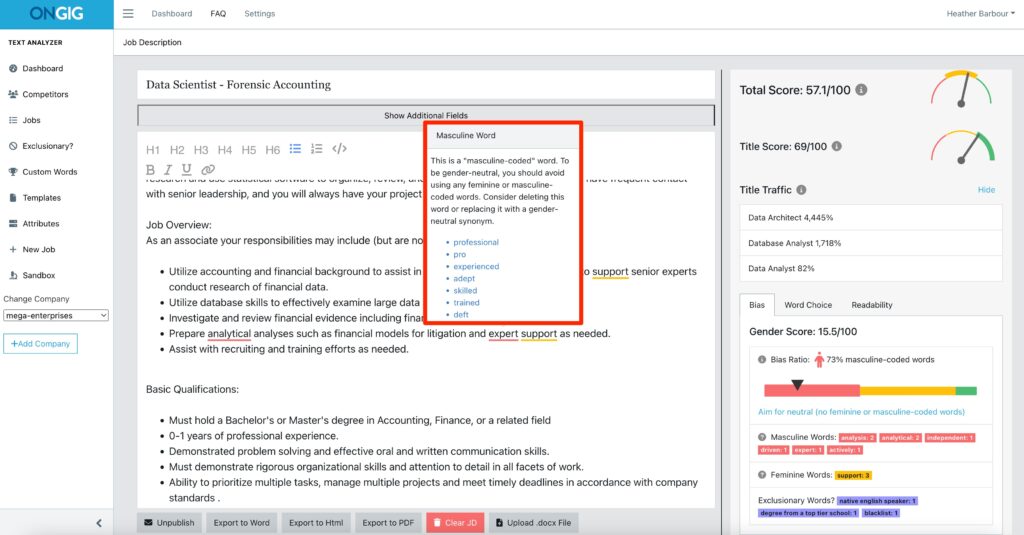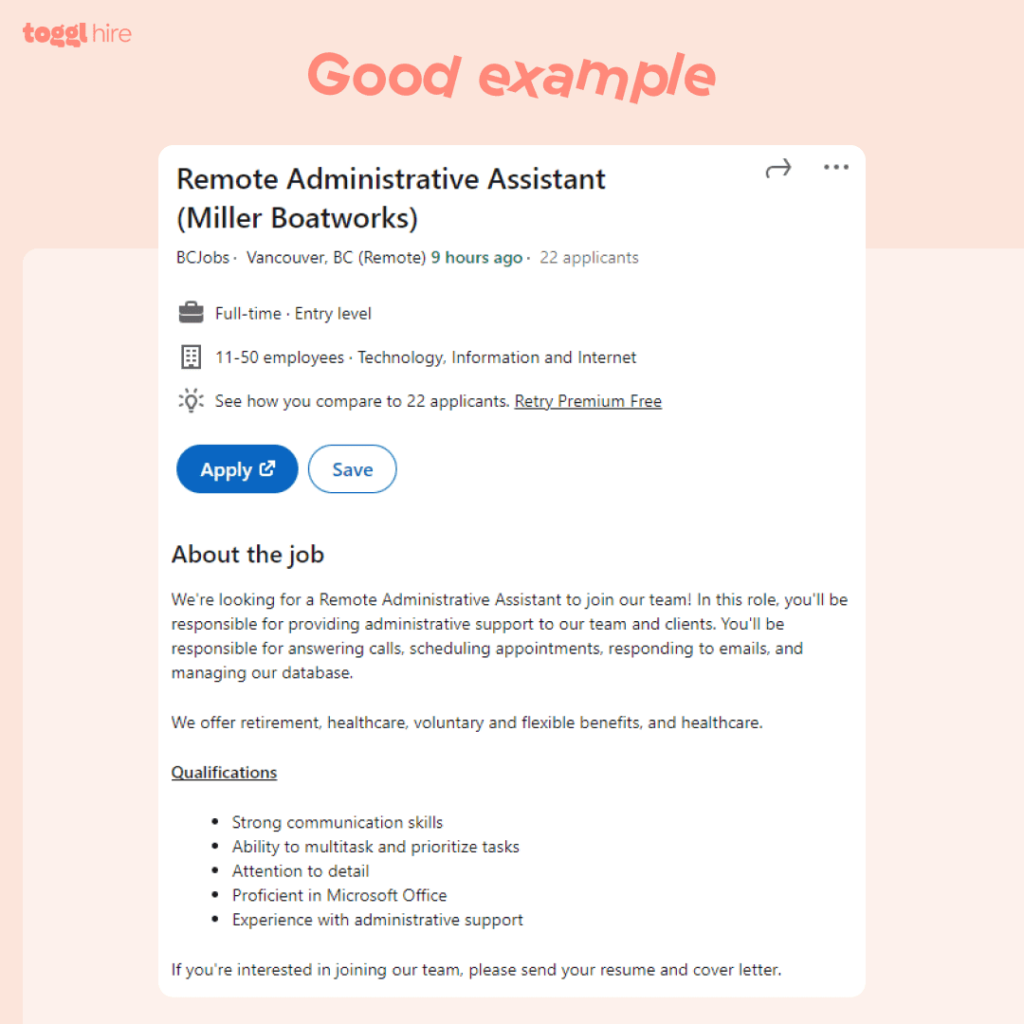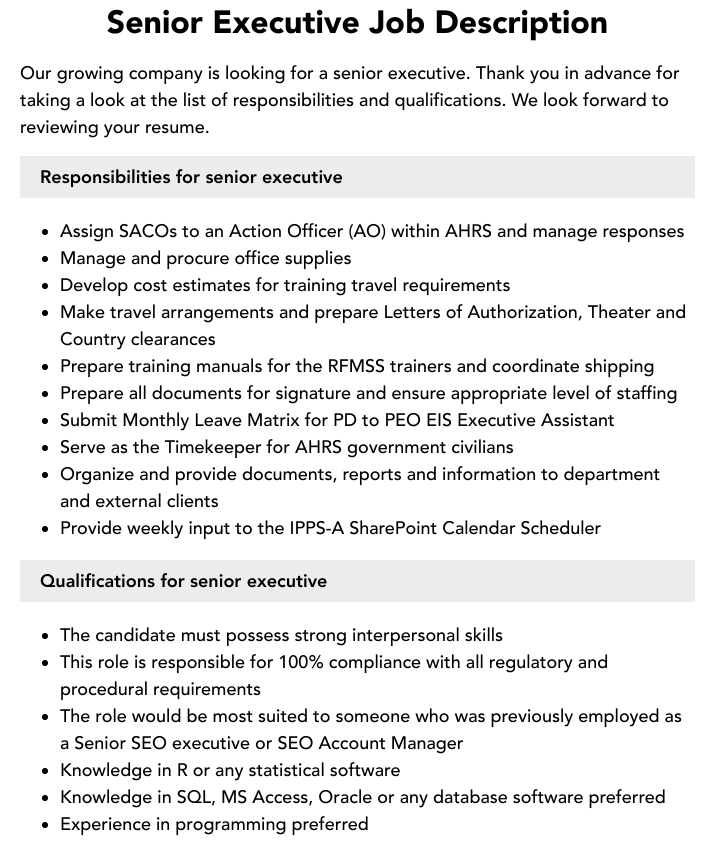- 10 Best Tips to Improve Your Diversity Hiring Strategy - September 6, 2024
- Recruiting on a Budget: 6 Free and Paid Tips in 2024 - June 24, 2024
- Knowledge Management in HR: How To Improve Your Hiring Process - April 25, 2024

There are many elements involved in attracting the best candidates to your open roles. But, an experienced HR pro knows that it all starts with observing job description best practices. The way you structure, brand, market, and write your job description has a big impact on your hiring strategy, and helps you attract the right candidates.
That’s why I created this post on effective job ads and 10 job description best practices to help attract top talent to your brand. Let’s dive in.
1. Use the Right Tools
First up, using job description tools is a great starting point. Tools like Ongig allow you to eliminate bias to make a good job description even better with engaging wording, and much more.
With Ongig, you can easily:
- Eliminate gender bias
- Eliminate exclusionary language
- Spruce up boring job listings
- Elevate wording or decrease complexity
- Ensure consistency across all job postings
- Eliminate inside jargon and buzzwords
- Optimize your job titles and optimize for SEO
There is a lot more that job description tools bring to the table. Any experienced HR pro knows the right tech can make all the difference for a hiring strategy.
Automating parts of this process with powerful tools also allows you to create job description templates to speed up the writing process, create consistency, and build effective hiring strategies for the future.
Keep in mind that automation is not just about reducing repetitive workloads. It’s also about improving your processes and supporting your employees to achieve better results.
2. Create a Consistent, Branded Format
Speaking of templates, one of the most important elements of a great job description is the brand and its consistency across all (online and offline) channels. No matter how and where you market your roles, it’s important to present a consistent brand image in your messaging.

One of the most important job description best practices is branding. So, make sure to brand your job descriptions with your unique visuals and tone of voice, weaving your culture, vision, and values into the mix. Do this consistently across all channels to boost your employer brand.
Here are the brand elements and how to include them:
- Visual identity. Whether it’s on social media, email, or your website, you have the chance to weave compelling visuals into your job descriptions. You can turn them into fun infographics and or engaging images featuring your workplace and employees. Just make sure that the visuals follow your brand’s style guide.
- Tone of voice. Your brand’s voice needs to be consistent across all online and offline channels—job descriptions included. Keep in mind the demographic you’re targeting with specific job listings, and consider the language these job seekers prefer. Adjust the language slightly if some listings are for millennials and others for Gen Z, for example.
- Culture and values. Have a dedicated section about the culture you nurture and the values you uphold as a collective. Don’t just mention these points in a wall of text. Instead, explain them in detail.
- Vision and purpose. Top talent is looking to be a part of something big, and your purpose and vision are going to inspire the most sought-after candidates to apply. These pillars will also elevate you above the faceless brands.
- Your collective and workplace. Nowadays, it’s more important than ever to showcase your positive collective and workplace. You can use images with explainer captions to engage the candidate, or you can portray your workplace through compelling storytelling.
3. Use the Power of Pay Transparency
Many talented job seekers won’t even consider applying for a job ad if the pay range is not listed (no matter their age), and that’s a good thing. So, this is one of the job description best practices that you should never ignore.
Long gone are the days of pay ambiguity. You want to harness the power of pay transparency in your job listings. For one, being open and transparent with the salary range for each position immediately sets you apart from the majority of companies, and incentivizes top talent to apply.
While you might be afraid of getting too many applicants if you list your pay ranges, you’ll actually find that the rate of applications will stay roughly the same, only now you won’t have to go through the entire interview process before finding out that the applicant had a different salary range in mind.
And, if you’re a new company or a startup, remember pay transparency is one of the most important qualities startups need for success. But it also applies to any business that wants to attract the best candidates.
4. The Importance of Diversity and Inclusivity as Job Description Best Practices
Inclusivity, diversity, equity, equality, and belonging. When it comes to job description best practices, these are not just phrases you need in your job descriptions; these are the tenets by which your brand lives and thrives. These are the values and policies you need to highlight in your job descriptions if you want to attract the most qualified job seekers.
Whether you are running a fully remote or a hybrid workplace, or if all your employees work at the office, these pillars need to permeate your teams.
Make sure to highlight your diversity and inclusivity initiatives, and don’t just gloss over them in your postings. Take an active approach to supporting different underrepresented communities, ethnicities, and genders.
These job seekers will want to know exactly what your company is doing to support them and their lifestyle. Including a section in your job descriptions with a solid diversity statement (even if it is generic) has proven to be valuable to diverse talent.
5. Explain Your Winning Company Culture
Simply saying you nurture a great culture at your organization is not enough. Sought-after job seekers are looking to get the details that will help them narrow their search. So the more info you provide the better the chance you’ll have to capture their attention.

For example, if one of the biggest aspects of your culture is hiring diversity, then go the extra mile to explain how you nurture a diverse work environment in your job descriptions. Here’s an example of a “company culture” statement from CVS’s job descriptions:
“We want everyone who works at CVS Health to feel empowered by the role they play in transforming our culture and accelerating our ability to innovate and deliver solutions to make health care more personal, convenient and affordable. We strive to promote and sustain a culture of diversity, inclusion and belonging every day.”
6. Highlight “Stand Out” Perks
When you’re writing JDs without following job description best practices, it’s easy to be so focused on your needs that you forget to highlight all the perks and benefits you offer. The most qualified candidates want to join organizations that understand the modern way of life and have made the necessary adjustments to support their lifestyle.
Highlight the perks that make you stand out, like medical travel or complete mental health support, college tuition repayment support, and more. Think about what you can afford and what your employees really need.
Run a quick survey to find out what perks and benefits matter the most to your current employees, which will give you an insight into what investments you need to make in the following year. Use that data to populate this section in your job descriptions.
These benefits are also proven to have the biggest impact on apply rates:
- Regular Incremental Bonus (+155.1%)
- Pet Insurance (+37%)
- Health Insurance (+29.8%)
- Stock Options/Employee Stock Purchase Plan (+27.5%)
- 401(k) (+20.5%)
7. Set a Clear Remote Work Scheme
Remote work is here to stay, and it’s important that your job postings reflect the state of remote work at your company. Many job seekers are wary of companies that tease the prospect of remote work but go back on their word once they secure the new hire.

That’s why you have to be as transparent as possible with your remote work arrangements. This approach is one of the best ways to keep your remote team motivated and to inspire the top talent to reach out.
A study from Team Blind found:
32% of working professionals would consider relocating with a paycut, if given the opportunity to work from home as much as they would like.
So, adding a section to your job descriptions dedicated to “remote work” is an excellent idea.
8. Avoiding Gendered Language is Vital to Job Description Best Practices
Gendered language can be extremely exclusionary and can hurt your employer brand. Avoid gendered language at all costs by running your job descriptions through a tool like Ongig’s Text Analyzer to find and replace this type of content. This is a great way to ensure your JDs follow job description best practices.

This process is essential when you’re editing job descriptions before posting to your career page, social media channels, job boards, and beyond.
Here is a quick checklist of job description best practices to follow when writing gender-neutral job descriptions:
- Gender-neutral job titles. Replace terms like “salesman” with “sales representative.
- Gender-neutral pronouns. Avoid using “he” or “she” and opt for “them,” “they,” “their,” or “you”.
- Avoid gender-coded words. Gendered descriptors like “aggressive,” “nurturing,” or “dominant” can reinforce stereotypes.
- Use inclusive language. Use language that’s inclusive of all genders, like “candidates,” “applicants,” or “employees,” instead of “men,” “women,” or “ladies and gentlemen.”
- Avoid common gendered terms. Avoid using gendered terms, such as “policeman,” “fireman,” or “stewardess.” Use gender-neutral terms, such as “police officer,” “firefighter,” or “flight attendant.”
9. Limit Your “Must-Haves”
Hiring managers often have a long list of job requirements for each position. However, to keep in line with job description best practices, you must limit and be realistic with your “must-have” skills.
It’s important to be reasonable when writing job descriptions and to only ask for the skills and experiences relevant to the position. After all, people want to feel secure in their decision to apply, and adding numerous must-haves and nice-to-haves will only make them doubt their abilities and worth.

Try to keep your list of responsibilities to 7 or fewer. 69% of candidates believe 8 or more role responsibilities (the day-to-day tasks of the role) in a job ad would serve as a deterrent to applying. Creating an endless list of requirements is also detrimental to your hiring strategy.
You’ll have a much easier time attracting the top talent with a concrete set of skills related to a specific position than trying to hire “someone who does everything” in the hopes of maximizing your payroll dollars.
10. Avoiding Cringey Keywords: One of the Most Important Job Description Best Practices
Last but not least, remember modern employees, and especially Gen Z job seekers, have a sixth sense for buzzwords and cringe language. Words like “dynamic,” “fast-paced,” “competitive,” “family,” “superstar,” “guru,” “self-starter,” “ninja,” and others are not the words you want to use to describe your company or your workplace.
These words often keep the best candidates for applying for your roles. Why? Because over time, people have come to associate these words with toxic work environments and shady brands that use ambiguous terms to mask their true nature.
You don’t want to be associated with those brands. Instead, you want to portray an honest, transparent, down-to-earth image to attract employees.
Remember, people have been burnt in the past. And, millennials and Gen Z steer clear of companies that use common buzzwords in their job postings.
Job Description Best Practices: Writing Entry-Level vs. Senior-Level Job Descriptions
When creating job descriptions, it’s important to tailor them to the specific experience levels you’re seeking. Whether you’re hiring for entry-level or senior-level positions, each will need a different approach to attract the right talent. So let’s break down the key differences between writing job descriptions for both levels.
Entry-Level Job Descriptions Best Practices
For entry-level job descriptions, you want to focus on the potential of your job applicants rather than years of experience. In this case, soft skills and necessary skills for the job role become more important than a long list of qualifications.
Start with a great job title that clearly reflects the role, like “Marketing Coordinator” or “Administrative Assistant.”
This will immediately catch the attention of potential candidates looking for their first job. Also, when listing job duties, make sure to keep it simple. So, use bullet points to highlight the most important tasks. Entry-level candidates don’t expect to know everything, so focus on the type of work they will be doing, along with the specific skills they can learn in the new role.
It’s also a good idea to include a section on training and employee benefits so candidates can see the value of this new position from the start. The goal is to create inclusive job descriptions that appeal to a broad range of diverse candidates. So this would include people of color and candidates from different backgrounds. This can help ensure you get a mix of potential employees for the job.
Lastly, don’t forget to make sure your job description template is clear and easy to read. Give candidates a clear understanding of what the hiring process looks like. Also, let them know how they can apply for the open job.
Check out the entry-level job description example from toggl hire below:

Senior-Level Job Descriptions Best Practices
Senior-level job descriptions, on the other hand, require more focus on required qualifications, years of experience, and key responsibilities. Since you’re looking for more experienced job candidates, include a detailed list of the most important aspects of the job, highlighting leadership roles, team collaboration, and essential job functions. So, for these roles, hard skills and specific skills are often emphasized more than soft skills.
It’s also important to outline the performance standards and expectations in terms of managing teams and driving company initiatives. Additionally, for senior roles, the right title matters more to attract potential hires who are serious about taking on high-level responsibilities. So, focus on showcasing the right fit for the new job, and don’t hesitate to mention working conditions and how the role fits into your company’s core values.
Unlike entry-level positions, senior roles may also include the hiring manager’s expectations for strategic thinking, decision-making, and industry expertise. This gives senior-level job applicants a clear understanding of what is expected in the new position and the potential job duties they will oversee. Therefore, being specific about these qualifications increases your chance of attracting the best talent for the role.
Check out the below senior-level job description sample from Velvet Jobs:

Job Description Best Practices: Tailoring for the Right Candidates
Whether you’re hiring for an entry-level or senior-level job, always make sure your job post accurately reflects the necessary skills and experience needed for the role. This is how you attract the right person for the open position. Also, keep in mind that the best job descriptions are those that resonate with potential candidates and make them feel like they’re a good fit for the job title. So, use a job analysis to determine which skills are essential and ensure the content of your job description aligns with the needs of your team.
Why I Wrote This:
Writing job descriptions that will attract qualified candidates that share your company’s culture is not easy. That said, there are clear, concise, and effective steps you can take today to make your job postings the best in the industry. And if you want to learn how Ongig’s software can support your mission, please request a demo.
Shout-outs:
- Here’s What Candidates Really Think About the Diversity Statements in Your Job Posts (by Greg Lewis)
- How to build a strong employer brand? (by RecruitCRM)
- 12 Qualities All Startups Need for Success in Their First Year (by Lexie Lu)
- The state of the hybrid workplace (by Dialpad & WeWork)
- Company Culture: The Essential 2023 Guide (Examples, Types and Benefits Included) (by LeaveBoard)
- Job Ad Content: How Benefits Impact Candidate Attraction (by Appcast)
- Killer Remote Working Benefits For Employers (by Ginni Agarwal)
- 5 Ways to Keep Your Remote Team Motivated (by GoHire)
- The Permanent Relocation: Pay Cut Edition (by Team Blind)
- What candidates look for in a job ad (by SEEK)
